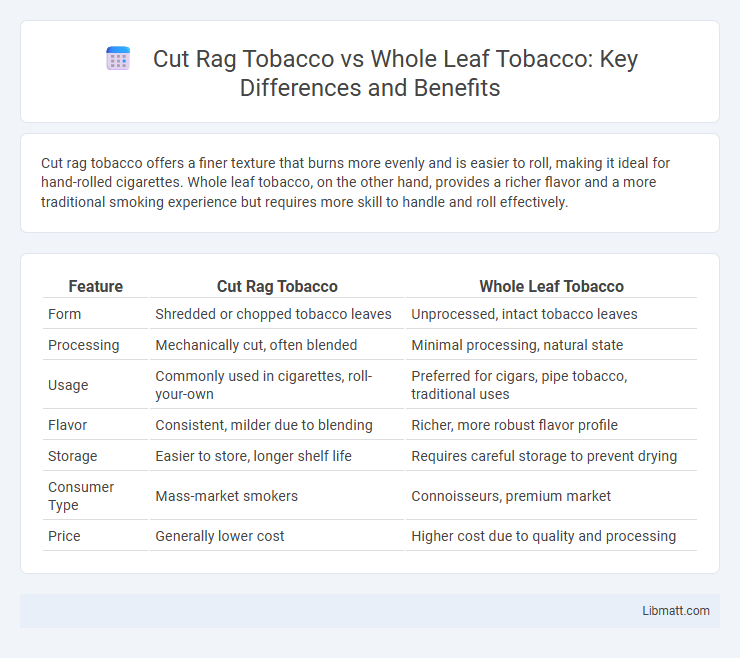Cut rag tobacco offers a finer texture that burns more evenly and is easier to roll, making it ideal for hand-rolled cigarettes. Whole leaf tobacco, on the other hand, provides a richer flavor and a more traditional smoking experience but requires more skill to handle and roll effectively.
Table of Comparison
| Feature | Cut Rag Tobacco | Whole Leaf Tobacco |
|---|---|---|
| Form | Shredded or chopped tobacco leaves | Unprocessed, intact tobacco leaves |
| Processing | Mechanically cut, often blended | Minimal processing, natural state |
| Usage | Commonly used in cigarettes, roll-your-own | Preferred for cigars, pipe tobacco, traditional uses |
| Flavor | Consistent, milder due to blending | Richer, more robust flavor profile |
| Storage | Easier to store, longer shelf life | Requires careful storage to prevent drying |
| Consumer Type | Mass-market smokers | Connoisseurs, premium market |
| Price | Generally lower cost | Higher cost due to quality and processing |
Introduction to Cut Rag Tobacco and Whole Leaf
Cut rag tobacco consists of finely shredded tobacco leaves, designed for easy rolling and consistent burning, making it popular among hand-rolling enthusiasts. Whole leaf tobacco includes uncut, intact leaves that offer a richer flavor and stronger aroma, often preferred for traditional cigars or pipe smoking. Your choice between cut rag and whole leaf tobacco depends on the desired smoking experience and preparation method.
Definition and Key Characteristics
Cut rag tobacco consists of shredded tobacco leaves processed into short strips, commonly used for rolling cigarettes or pipe smoking, offering quicker ignition and smoother burn. Whole leaf tobacco refers to intact, uncut leaves prized for their richer flavor, higher nicotine content, and use in premium cigars or handmade cigarettes. Your choice between cut rag and whole leaf depends on preferred smoking experience, flavor intensity, and convenience.
Processing Methods Compared
Cut rag tobacco undergoes a mechanical chopping process that slices the leaves into small pieces, facilitating easier packing and quicker burning. Whole leaf tobacco retains the entire leaf without fragmentation, preserving its natural oils and flavor, which is preferred in hand-rolled cigarettes and premium cigars. Your choice between cut rag and whole leaf affects the tobacco's texture, burn rate, and overall smoking experience due to these distinct processing methods.
Flavor Profiles and Aromatic Differences
Cut rag tobacco offers a more intense and immediate flavor due to its increased surface area, which enhances the release of rich, robust aromas during smoking. Whole leaf tobacco preserves the natural oils and subtle nuances of the leaf, providing a smoother, more complex flavor profile with delicate aromatic notes. Your choice between cut rag and whole leaf tobacco will significantly influence the sensory experience, tailoring the intensity and character of the aroma to your preference.
Impact on Smoking Experience
Cut rag tobacco offers a quicker, more intense burn due to its smaller particle size, resulting in a stronger flavor and faster nicotine delivery, catering to smokers who prefer a robust, immediate impact. Whole leaf tobacco provides a smoother, slower-burning experience with richer, more nuanced flavors, appealing to those who enjoy a more leisurely, refined smoking session. The choice between cut rag and whole leaf significantly influences the balance of taste, burn rate, and nicotine absorption in the smoking experience.
Cost and Economic Considerations
Cut rag tobacco typically offers a lower upfront cost compared to whole leaf tobacco due to its processing and packaging efficiency. Economically, whole leaf tobacco can provide better value for premium products, as it retains more natural oils and flavors, appealing to connoisseurs willing to pay higher prices. Consumers and manufacturers must weigh the affordability of cut rag tobacco against the quality and market positioning advantages of whole leaf tobacco.
Popular Uses and Applications
Cut rag tobacco is primarily favored for rolling cigarettes and hand-rolled cigars due to its fine, consistent texture that ensures even burning and easy packing. Whole leaf tobacco is commonly used in premium cigar manufacturing and pipe smoking, valued for its intact leaves that provide richer flavor profiles and a more traditional smoking experience. Both forms are essential in tobacco product customization, catering to different consumer preferences and production methods.
Storage and Shelf Life
Cut rag tobacco requires airtight storage in a cool, humid environment to maintain freshness and prevent dryness, which can reduce its shelf life to several months if improperly stored. Whole leaf tobacco retains moisture longer due to its unprocessed state, allowing for a longer shelf life when stored properly in sealed containers with controlled humidity levels. You can extend the quality and flavor of both types by avoiding exposure to air, heat, and light during storage.
Health and Safety Aspects
Cut rag tobacco exposes users to higher levels of nicotine and tar compared to whole leaf tobacco, increasing the risk of respiratory diseases and cardiovascular problems. Whole leaf tobacco, being less processed, may contain fewer additives and chemicals, potentially reducing some health risks. However, both forms still deliver harmful carcinogens and pose serious safety concerns for users and those exposed to secondhand smoke.
Consumer Preferences and Market Trends
Cut rag tobacco offers convenience and faster burning, appealing to consumers who prefer quick rolling and even burn rates, while whole leaf tobacco attracts purists seeking traditional flavor and control over the rolling process. Market trends indicate a steady demand for cut rag due to its ease of use and consistent quality, though niche markets for whole leaf tobacco remain strong among artisanal and premium smokers. Consumer preferences increasingly favor customizable smoking experiences, driving growth in both segments depending on lifestyle and smoking habits.
Cut rag tobacco vs whole leaf Infographic

 libmatt.com
libmatt.com